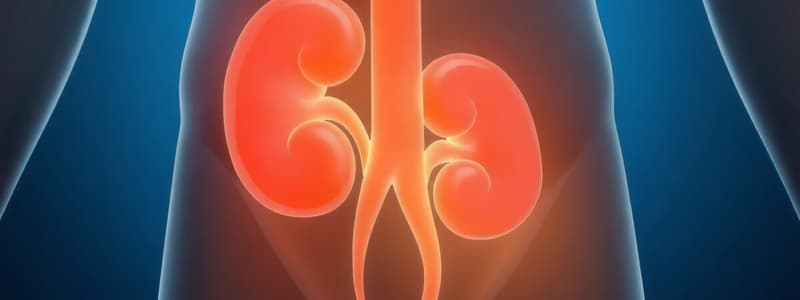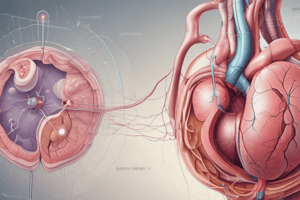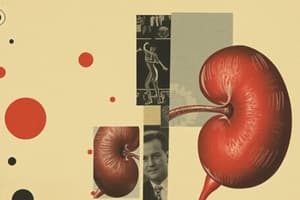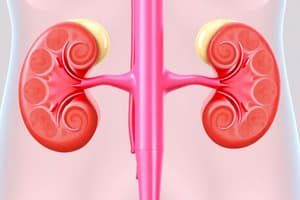Podcast
Questions and Answers
Match the following functions to the correct organ shown in the diagram:
Match the following functions to the correct organ shown in the diagram:
excretes carbon dioxide = 1 excretes urea = 2 produces urea = 3
Which row describes the functions of the bladder, kidneys and liver?
Which row describes the functions of the bladder, kidneys and liver?
production of urea = liver excretion of urea = kidneys storage of urine = bladder
Which row correctly shows the organ where each substance is excreted?
Which row correctly shows the organ where each substance is excreted?
carbon dioxide = lungs excess water = kidneys salts = liver urea = skin
Where does filtration occur?
Where does filtration occur?
During filtration, protein molecules do not pass through the wall of the glomerulus. Which part contains the highest concentration of protein?
During filtration, protein molecules do not pass through the wall of the glomerulus. Which part contains the highest concentration of protein?
Flashcards
Deamination
Deamination
The process of removing the nitrogen-containing part of amino acids to form urea.
Urea
Urea
A waste product containing nitrogen, produced during the breakdown of amino acids in the liver and excreted by the kidneys.
Excretion
Excretion
The removal of metabolic waste products from the body.
Cortex
Cortex
Signup and view all the flashcards
Medulla
Medulla
Signup and view all the flashcards
Ureter
Ureter
Signup and view all the flashcards
Filtration
Filtration
Signup and view all the flashcards
Glomerulus
Glomerulus
Signup and view all the flashcards
Filtrate
Filtrate
Signup and view all the flashcards
Reabsorption
Reabsorption
Signup and view all the flashcards
Proximal Convoluted Tubule (PCT)
Proximal Convoluted Tubule (PCT)
Signup and view all the flashcards
Loop of Henle
Loop of Henle
Signup and view all the flashcards
Distal Convoluted Tubule (DCT)
Distal Convoluted Tubule (DCT)
Signup and view all the flashcards
Kidney
Kidney
Signup and view all the flashcards
Bladder
Bladder
Signup and view all the flashcards
Blood Regulation
Blood Regulation
Signup and view all the flashcards
Urine Formation
Urine Formation
Signup and view all the flashcards
Sweating
Sweating
Signup and view all the flashcards
Breathing (Exhalation)
Breathing (Exhalation)
Signup and view all the flashcards
Egestion
Egestion
Signup and view all the flashcards
Waste Products
Waste Products
Signup and view all the flashcards
Dialysis
Dialysis
Signup and view all the flashcards
Kidney Failure
Kidney Failure
Signup and view all the flashcards
Overhydration
Overhydration
Signup and view all the flashcards
Dehydration
Dehydration
Signup and view all the flashcards
Solute
Solute
Signup and view all the flashcards
Solvent
Solvent
Signup and view all the flashcards
Solution
Solution
Signup and view all the flashcards
Concentration
Concentration
Signup and view all the flashcards
Homeostasis
Homeostasis
Signup and view all the flashcards
Study Notes
Excretion in Humans
- Deamination: The removal of the nitrogen-containing part of amino acids to form urea.
- Urea Formation: Urea is formed from excess amino acids in the liver and excreted by the kidneys, not in the kidneys & excreted by the liver.
Organ Function Matching
- Excretes carbon dioxide: Lungs
- Excretes urea: Kidneys
- Produces urea: Kidneys
Urine Production and Temperature
- Urine Production Study: An experiment investigated the effect of temperature on urine volume, where environmental temperature increased from 20°C to 40°C, with no other changes made.
- Increased temperature: 120 cm³/hour before to 145 cm³/hour after,
Filtrate Components
- Filtrate Substances: The filtrate in the glomerulus normally contains glucose and urea. Glucose is absent, urea is present.
Kidney Structure and Function
- Regions: The kidney is composed of cortex, medulla, and ureter.
- Filtration Location: Filtration takes place in the glomerulus within the kidney cortex.
- Substance Re-absorption: Glucose is entirely reabsorbed from the fluid in the kidney tubules, it returns into the blood in the kidney tubules.
Dialysis and Kidney Function
- Proper Dialysis Composition: Fresh dialysis fluid lacks bile, glucose, salts, and water, but contains other critical components for proper balancing.
Specific Substances and Locations
-
Glucose and Urea Concentration: The concentration of glucose in urine is often higher than its concentration in blood plasma. The concentration of urea in urine is higher in comparison with blood plasma).
-
Urea Production Location: Urea is produced as a result of the removal of the nitrogen-containing parts of amino acids in the liver.
-
Filtration of blood: Substances filtered in the glomerulus: glucose, salts, urea, and water.
Studying That Suits You
Use AI to generate personalized quizzes and flashcards to suit your learning preferences.





